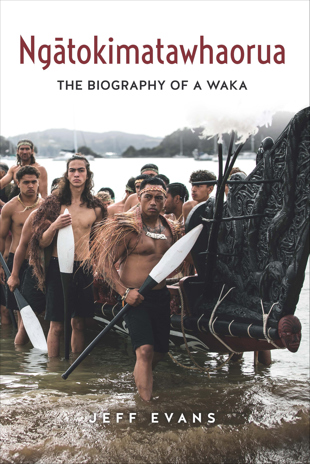Anna Knox reviews Ngātokimatawhaorua: The biography of a waka by Jeff Evans for New Zealand Heritage magazine:
‘Ngātokimatawhaorua, the waka championed by Te Kirihaehae Te Puea Hērangi (Princess Te Puea) for the 1940 Te Tiriti o Waitangi centennial celebrations, is currently housed at the Waitangi Treaty Grounds. At 37.5 metres long, the waka taua is the largest in existence and of great value and significance, especially for northern iwi and to the Polynesian waka revival movement. As Pita Tipene explains in his foreword, the waka shares its name with the ancestral Ngātokimatawhaorua in which Kupe returned to Hawaiki, so is also a tupuna, and its story therefore a biography.
The book moves chronologically, beginning in 1937, as master waka builder Rānui Maupakanga searches Puketi Forest for two kauri trees large enough to fit the vision of Te Puea (Jeff finds what could possibly be one of the stumps). The first half is engrossing, detailing the felling of the trees, the shaping, transportation and carving of the enormous vessel, the training of kaihoe and, finally, the centennial celebrations.
We follow Jeff into the forest, zoom up close to the men working under the karakia of the tohunga as they learn and teach the ancient skills of waka building, and watch with 10,000 awed spectators as Ngātokimatawhaorua makes its way into Hobson Beach. This textured and vibrant history is supported by the film and photography work of Jim Manley, whom Te Puea sanctioned to document the project, despite the tapu nature of the work.
The second half of the book, charting the fate of Ngātokimatawhaorua after the centennial, moves faster, and at times the biography of the waka is subsumed by the larger waves of its contexts. But as Pita Tipene observes, “for such an important taonga … it is a mystery why there is so little written information about this storied waka”. Jeff Evans has given us some.’


